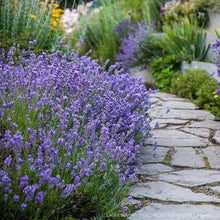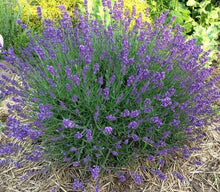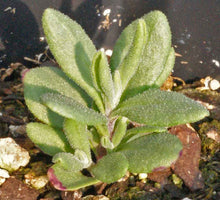Up for sale is one pack of 400+ True English Lavender flower seeds. The most fragrant of the lavenders these perennials are for zone 6-9 and do not tolerate extreme cold weather. When shopping for English Lavender make sure you are buying Lavandula Angustifolia Vera and not other varieties of Lavender such as Munstead or Ellagance that are not True English Lavender.
We offer flat rate combined shipping on all orders, no limit on the amount or type of seed packets.
CULTURE
Soil temperature: 72 degrees fahrenheit
Germination lighting: Light
Germination days: 14-21 days
Weeks indoor: 10 Weeks
Seed Depth: 1/8" inch
Seed Spacing: 20 inches
Plant spread: 18 inches
Plant height: 20-30"
Plant type: Perennial
Maturation days: 365 days
Lavender is best grown over winter in pots and then transplanted into your garden after the last frost, but bewarned they do require a bit a patience as they can germinate in a couple of weeks or couple of months. You can sow them directly into your garden but results will not be as good as starting early in pots.
Direct Seed: If in zones 6-7 you can direct seed these into your garden in fall after your last frost. Work your enriched garden bed 6" deep and scatter seeds on the surface as they need light to germinate. Top with a light dusting of peat. In zones 8-9 you will have to cold treat your seeds before seeding. Take your packet of seeds and mix with 1 tablespoon of screened peat moss or sand inside a ziploc baggie. Add 1 teaspoon of water of water and mix until the peat is damp and place the sealed baggie in your refrigerator for 60 days. After 60 days take out of the refrigerator and let dry. Mix with two cups of screened peat before sprinkling the peat/seed mix in your garden area.
In Pots: Seeds require cold treatment to germinate prior to seeding indoors (seed cold treat instructions above). After cold treatment use a non soil potting mix made of 1 part sand and 1 part peat or a sterilized seed potting mixture. Sprinkle 5-8 seeds in each pot, or use a tray and sow them in rows 3" apart, and press into soil. Cover lightly with sand or vermiculite as they need light to germinate. Don't oversaturate and water from the bottom of your pot. We cover our trays or pots with plastic wrap until the seeds start to germinate (don't let the seedlings touch the plastic wrap). They are slow to germinate, and while germinating the need lighting but dislike strong direct natural sunlight. Keep you soil temperature around 70 degrees which in winter might require the use of a heating mat.
Once plants get their second set of leaves you can add a mild fertilizer to their water. In spring, after your last frost, transplant into your garden. Once in the garden for one year cut back in the very early spring to encourage bushy growth. If you seeds fail to germinate when starting in pots don't give up on them. In spring prepare your garden area and scatter your potting/seed mixture on the surface and give them until the following fall.
We offer flat rate combined shipping on all orders, no limit on the amount or type of seed packets.
CULTURE
Soil temperature: 72 degrees fahrenheit
Germination lighting: Light
Germination days: 14-21 days
Weeks indoor: 10 Weeks
Seed Depth: 1/8" inch
Seed Spacing: 20 inches
Plant spread: 18 inches
Plant height: 20-30"
Plant type: Perennial
Maturation days: 365 days
Lavender is best grown over winter in pots and then transplanted into your garden after the last frost, but bewarned they do require a bit a patience as they can germinate in a couple of weeks or couple of months. You can sow them directly into your garden but results will not be as good as starting early in pots.
Direct Seed: If in zones 6-7 you can direct seed these into your garden in fall after your last frost. Work your enriched garden bed 6" deep and scatter seeds on the surface as they need light to germinate. Top with a light dusting of peat. In zones 8-9 you will have to cold treat your seeds before seeding. Take your packet of seeds and mix with 1 tablespoon of screened peat moss or sand inside a ziploc baggie. Add 1 teaspoon of water of water and mix until the peat is damp and place the sealed baggie in your refrigerator for 60 days. After 60 days take out of the refrigerator and let dry. Mix with two cups of screened peat before sprinkling the peat/seed mix in your garden area.
In Pots: Seeds require cold treatment to germinate prior to seeding indoors (seed cold treat instructions above). After cold treatment use a non soil potting mix made of 1 part sand and 1 part peat or a sterilized seed potting mixture. Sprinkle 5-8 seeds in each pot, or use a tray and sow them in rows 3" apart, and press into soil. Cover lightly with sand or vermiculite as they need light to germinate. Don't oversaturate and water from the bottom of your pot. We cover our trays or pots with plastic wrap until the seeds start to germinate (don't let the seedlings touch the plastic wrap). They are slow to germinate, and while germinating the need lighting but dislike strong direct natural sunlight. Keep you soil temperature around 70 degrees which in winter might require the use of a heating mat.
Once plants get their second set of leaves you can add a mild fertilizer to their water. In spring, after your last frost, transplant into your garden. Once in the garden for one year cut back in the very early spring to encourage bushy growth. If you seeds fail to germinate when starting in pots don't give up on them. In spring prepare your garden area and scatter your potting/seed mixture on the surface and give them until the following fall.






